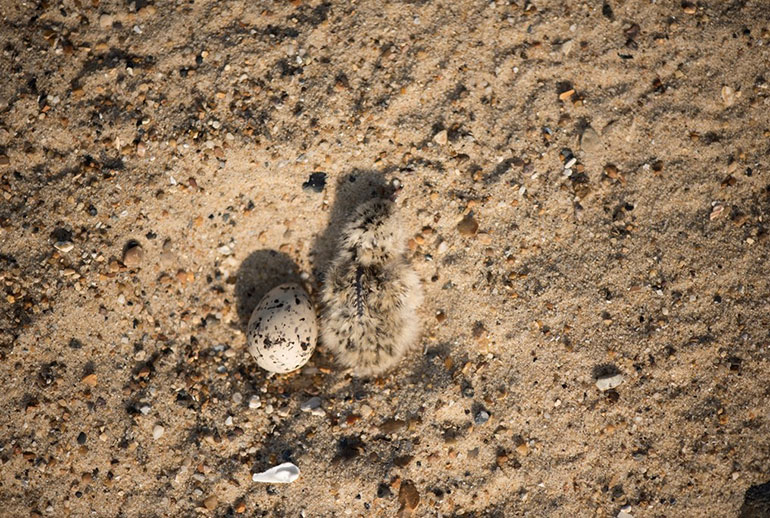Nature & Wildlife | Posted on March 31st, 2021 | return to news
RSPB celebrates breeding success of seabirds in 2020
According to the RSPB, last year saw a huge number of threatened seabirds successfully breed along England’s south coast.

Little tern
The Royal Society for the Protection of Birds has reported that over 30 little terns, one of the UK’s rarest breeding seabirds, fledged at Chesil beach and a further 15 at RSPB Pagham Harbour in West Sussex.
Little terns nest on beaches and are recognised by their small size and distinctive black beak with a yellow tip. As last year saw some of the highest tides recorded, and with a spike in visitors after the easing of lockdown, the terns faced a series of challenges.
A team of RSPB staff and volunteers installed fencing and signage at Pagham Harbour, and patrolled the nesting sites to make sure parents and chicks had the space they needed to thrive.
This success continued along the coast at Chesil beach, in Dorset, where similar work (funded by Portland Court Leet, the Environment Agency and Dorset Council) led to the largest number of breeding pairs since work began in 2009.

Common tern
Common terns, sometimes called ‘sea swallows’ because of their long tails, also thrived in the south of England last year.
On Hayling Island, RSPB staff launched rafts into the lagoon at the West Hayling Local Nature Reserve to provide a safe haven for returning common terns. This resulted in 56 chicks taking to the skies.
Similar work to manage nesting habitats and protect nests led to the highest number of common tern chicks fledging in nearly a decade at RSPB Lodmoor in Dorset with a total of 90 new chicks.
The success continued to the east as at least 90 additional chicks fledged at RSPB Dungeness, Kent.

Sandwich tern
RSPB Pagham Harbour saw a record 164 sandwich tern chicks hatched on ‘tern island’ the RSPB’s creation of shingle habitat with protective fencing. Sandwich terns breed around the UK coast in summer, but they nest directly on the ground which puts them at a higher risk of predation, human disturbance and flooding. Because of this, they rely almost entirely on nature reserves.
Mediterranean gulls
Mediterranean gulls also saw huge success with 1,579 pairs nesting at RSPB Langstone Harbour in Hampshire – the second highest total ever recorded. They were once very rare but are now breeding around the UK coast in increasing numbers. Last year also saw the first pair nest at RSPB Lodmoor and the first-ever chick to fledge from there.
Comment
Richard Archer, RSPB conservation officer said: “The coastal habitats that these birds rely on are shrinking, so restoring and creating suitable habitat is vital to their survival.
“The success of our little tern numbers has led to the highest number of breeding little terns in over a decade and reflects a huge amount of planning, hard work and innovation.
“Our volunteers, operating under Covid-19 restrictions, have been fantastic. If they can breed successfully, little terns will often return to the same nesting beach every year, so it’s a really positive sign that the work we are doing here will support the future of these vulnerable birds.”
Wez Smith, RSPB site manager said: “The future of our coastal breeding birds remains in a perilous state here on the south coast of England but it’s reassuring to see our ongoing work bearing positive results.
“Once again, this shows that when our shore nesting birds are protected in suitable coastal habitat and given space, they can thrive.
“Taking action to allow increasingly rare birds like little terns to nest on beaches near populated areas along with creating new sites to replace those that have been lost is a real sign of progress. I
“It’s vital that we can continue our ongoing work to protect wildlife and the habitats they require to thrive.
“The truly amazing success for breeding terns at RSPB Pagham Harbour is a particular moment to be treasured in our coastal conservation work and should see a newly invigorated population of young sandwich and little terns returning over the coming years.”

How can you help?
Over half of England’s most threatened breeding bird species are ground-nesting which can leave them at risk of predators, human disturbance, and flooding.
As nesting season begins there are some simple ways to help protect our most threatened beach-nesting birds this year.
A key thing you can do is simply watch where you walk. Stick to the paths, watch out for signage, and keep your dog on a lead when walking on beaches and coastlines. When off leads, dogs can run through nesting areas, causing stress to breeding birds.
When walking across open shingle, look and listen out for alarmed birds, as these are usually a good indicator there is a nest nearby. If you do hear alarm calls, please back away to avoid disturbing them further.
With the support of members, the RSPB can create ideal habitat for threatened birds. This habitat helps keep nesting birds and their chicks safe but, as a charity, the RSPB can only continue this vital work if people support them. More than a million people already support the RSPB’s work as members.
For more information visit: www.rspb.org.uk/join-and-donate/join-us/
Please share post:








